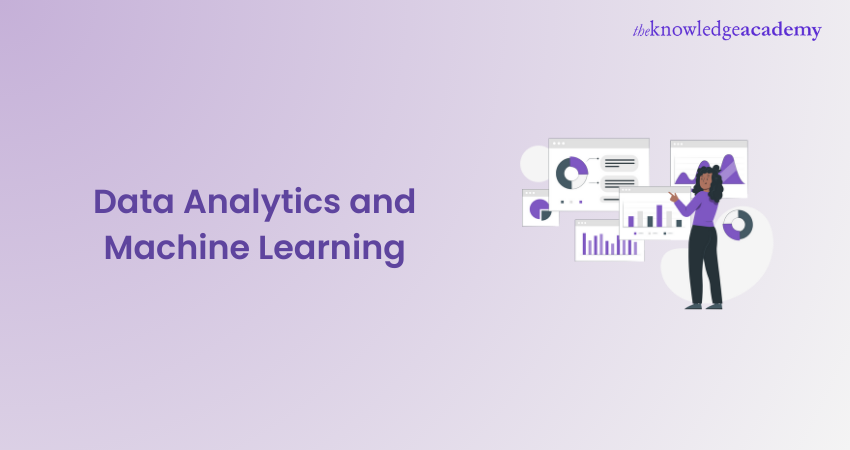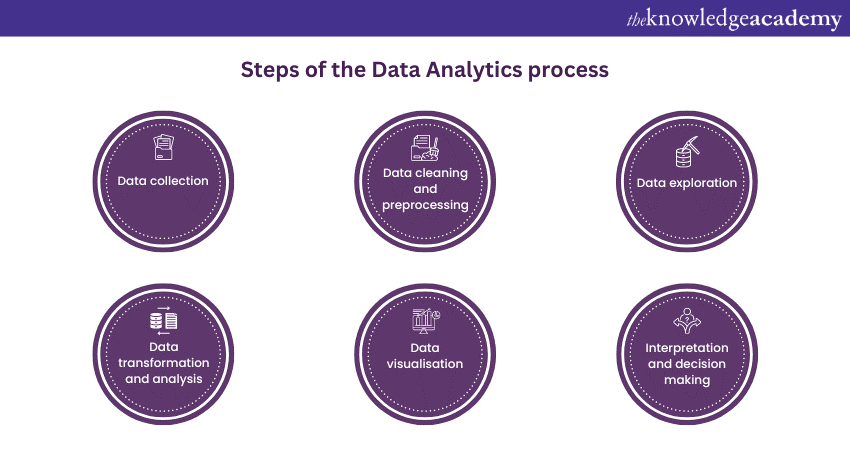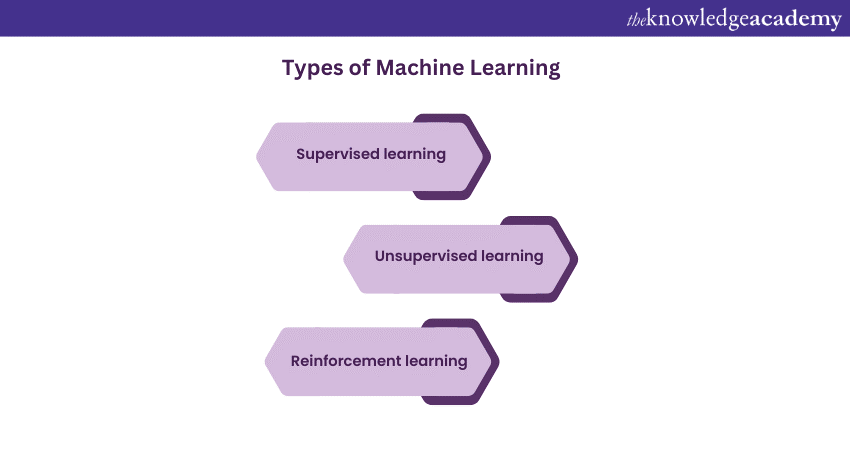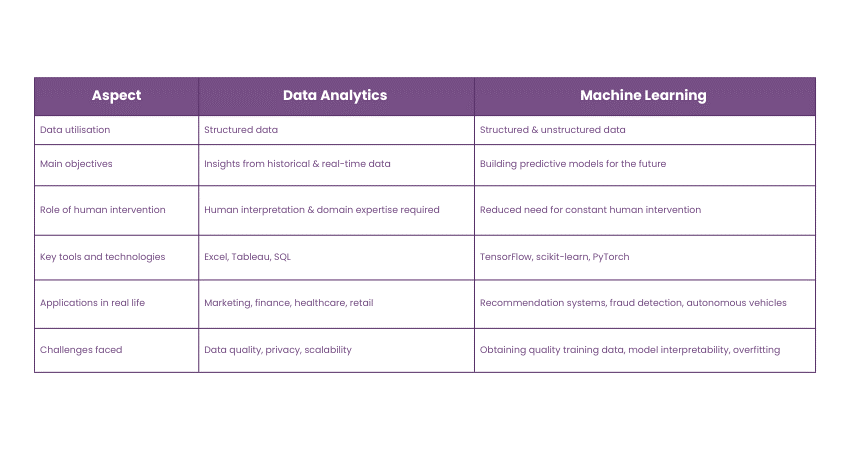We may not have the course you’re looking for. If you enquire or give us a call on 01344203999 and speak to our training experts, we may still be able to help with your training requirements.
Training Outcomes Within Your Budget!
We ensure quality, budget-alignment, and timely delivery by our expert instructors.

Drowning in data? Feeling lost in a sea of numbers? You're not alone. Businesses today are generating data at an unprecedented rate. But what good is all that information if you can't unlock its secrets? That's where Data Analytics and Machine Learning come in. Data Analytics helps you understand what's happening in your data - trends, patterns, and hidden insights. Machine Learning takes it a step further, empowering computers to learn from that data and make predictions about the future.
Confused about the difference between Data Analytics and Machine Learning? This blog cuts through the jargon and explains what sets these two powerful tools apart. Keep reading to discover how Data Analytics and Machine Learning can transform your business!
Table of Contents
1) What is Data Analytics?
2) Skills Required to Become a Data Analyst
3) What is Machine Learning?
4) Skills Required to Become a Machine Learning Engineer
5) Data Analytics and Machine Learning: What are the Differences?
a) Data Utilisation
b) Main Objectives
c) Role of Human Intervention
d) Key Tools and Technologies
e) Applications in Real Life
f) Challenges Faced
6) Conclusion
What is Data Analytics?
Data Analytics, a vital discipline in the domain of Data Science, revolves around the exploration, examination, and interpretation of vast datasets to glean valuable insights and meaningful patterns. It is a process of converting raw data into actionable information, enabling businesses and organisations to make informed decisions and drive growth.
At its core, Data Analytics involves the use of statistical and mathematical techniques to dissect data and uncover trends, relationships, and correlations. These analyses help businesses gain a comprehensive understanding of their operations, customer behaviour, market trends, and much more. By harnessing the true power of Data Analytics, businesses can optimise processes, enhance performance, and stay ahead in the modern data-driven world.
The Data Analytics process can be broken down into several key steps:

a) Data Collection: The initial step in Data Analytics involves gathering data from various sources. This data can be structured (e.g., databases, spreadsheets) or unstructured (e.g., text, images, audio) and may originate from internal systems, customer interactions, social media, or external databases.
b) Data Cleaning and Preprocessing: Raw data often contains errors, missing values, and inconsistencies. Analysts clean and preprocess the data by removing irrelevant information, handling missing values, and standardising the format to ensure accuracy and consistency.
c) Data Exploration: After preparing the data, analysts perform Exploratory Data Analysis (EDA) to understand its characteristics better. This involves using charts, graphs, and descriptive statistics to visualise the data and identify initial patterns.
d) Data Transformation and Analysis: In this stage, analysts apply various statistical and mathematical techniques to extract meaningful insights from the data. Techniques such as regression, clustering, and classification are commonly used to uncover relationships and trends.
e) Data Visualisation: Data visualisation is a critical aspect of Data Analytics. Presenting data in visual formats, such as charts, graphs, and dashboards, enhances the comprehension of complex information and allows decision-makers to grasp insights quickly.
f) Interpretation and Decision-Making: Analysts interpret the results of their analyses, drawing actionable conclusions that guide decision-making. These insights are shared with stakeholders to inform business strategies and drive improvements.
Supercharge your data skills with our Big Data and Analytics Training. Register now!
Skills Required to Become a Data Analyst
a) Data Cleaning and Preprocessing: Data analysts must excel at cleaning and preprocessing data, which involves handling missing values, removing duplicates, and addressing data quality issues to ensure the data is suitable for analysis.
b) Data Visualisation: Proficiency in creating clear and informative data visualisations using tools like Matplotlib, Seaborn, or Tableau is essential. Effective visualisation helps communicate findings to stakeholders.
c) Programming & SQL: Knowledge of programming languages such as Python or R is crucial for data analysis. SQL is necessary for querying and retrieving data from relational databases, allowing analysts to access relevant data.
d) Domain Knowledge: Industry-specific knowledge is valuable as it helps analysts understand the context of the data and interpret findings effectively.
e) Data Interpretation: The ability to interpret data within a business or research context is essential. Analysts should provide actionable insights and recommendations based on their analysis.
f) Problem-Solving Skills: Strong problem-solving skills are needed to identify and define data-related challenges and formulate analytical approaches to address them.
g) Critical Thinking: Analysts must critically evaluate data sources, methodologies, and results to ensure the accuracy and reliability of their analyses.
h) Data Ethics: Understanding ethical considerations related to data analysis, including data privacy and security, is important.
i) Data Tools: Familiarity with data analysis tools and libraries such as Pandas, NumPy, or Jupyter Notebook is beneficial for streamlining data analysis tasks.
j) Business Acumen: Understanding the business context and goals is crucial. Data analysts should align their analyses with the organisation's objectives.
What is Machine Learning?
Machine Learning, known as a subset of Artificial Intelligence (AI), is a cutting-edge field that empowers computer systems to learn from data and enhance their performance over time without being explicitly programmed. Inspired by the learning process of the human brain, Machine Learning algorithms allow computers to recognise patterns, make predictions, and make decisions autonomously.
The core concept of Machine Learning lies in its ability to identify and learn from patterns within datasets. The process begins with training the Machine Learning model on a vast amount of labelled data, where the desired outcomes are already known. During the training phase, the model iteratively adjusts its internal parameters to minimise errors and improve accuracy in making projections.
Once the model has been trained, it can be used with new, unseen data to make informed decisions or generate predictions. As it encounters more data, the model continues to adapt and refine its predictions, making it increasingly proficient over time. Machine Learning can be broadly categorised into three main types:

a) Supervised Learning: In supervised learning, the model is trained on labelled data, where both the input and the corresponding output are provided. The algorithm learns to map inputs to correct outputs, enabling accurate predictions on new, unseen data. Common applications include image classification, sentiment analysis, and regression tasks.
b) Unsupervised Learning: Unsupervised learning involves training the model on unlabelled data, allowing the algorithm to discover hidden patterns or structures within the data. It identifies clusters and groups similar data points based on their attributes. Typical applications include clustering and dimensionality reduction.
c) Reinforcement Learning: Reinforcement learning is a unique form of machine learning where the model learns by interacting with a specific environment and receiving feedback in the form of rewards or penalties. The algorithm aims to maximise the total reward over time, making it suitable for tasks involving decision-making in dynamic environments.
Want to unlock the power of Big Data Analysis? Join our Big Data Analysis Course today!
Skills Required to Become a Machine Learning Engineer
a) Programming Skills: Proficiency in Python, R, or Julia is crucial. These languages are used to implement machine learning algorithms, preprocess data, and build applications.
b) Mathematics and Statistics: Knowledge of linear algebra, calculus, and statistics is essential for understanding the fundamental principles of machine learning algorithms.
c) Machine Learning Algorithms: Familiarity with various machine learning algorithms, including supervised learning (e.g., regression, classification), unsupervised learning (e.g., clustering, dimensionality reduction), and deep learning, is necessary.
d) Data Preprocessing: The ability to clean, preprocess, and transform raw data into a suitable format for machine learning is a foundational competency.
e) Data Visualisation: Proficiency in data visualisation libraries like Matplotlib, Seaborn, or Plotly is important for visualising data and model performance to effectively communicate results.
f) Machine Learning Frameworks: Knowledge of popular machine learning libraries and frameworks like scikit-learn, TensorFlow, PyTorch, and Keras is essential for building and training models.
g) Feature Engineering: Skill in creating meaningful features from raw data to improve model performance.
h) Model Evaluation: Evaluating the effectiveness of machine learning models involves using metrics such as accuracy, precision, recall, F1-score, and ROC-AUC.
i) Hyperparameter Tuning: Experience with hyperparameter tuning techniques to optimise model performance.
j) Version Control: Expertise in using version control systems such as Git for monitoring code changes and facilitating teamwork.
k) Cloud Computing: Familiarity with cloud platforms like AWS, Azure, or Google Cloud for scalable machine learning deployment.
l) Databases and SQL: Knowledge of databases and SQL for data retrieval and storage.
m) Deep Learning: Understanding of deep learning architectures and frameworks for tasks like image recognition, natural language processing, and reinforcement learning.
n) Natural Language Processing (NLP): If interested in NLP, knowledge of techniques like word embeddings, sentiment analysis, and named entity recognition is valuable.
o) Computer Vision: If interested in computer vision, skills in image processing, object detection, and image classification are essential.
Data Analytics and Machine Learning: What are the Differences?
Now that we know what Data Analytics and Machine Learning are, we will look into a detailed comparison of Data Analytics vs Machine Learning. This blog section will expand on the difference between Data Analytics and Machine Learning below.

Data Utilisation
Data Analytics primarily deals with structured data, which is organised in a tabular format, such as databases and spreadsheets. It involves the extraction of valuable insights and patterns from historical and real-time data. Analysts use statistical and mathematical techniques to identify trends, correlations, and anomalies within the data. The emphasis is on understanding past performance and optimising processes based on historical data.
Machine Learning, on the other hand, can handle both structured and unstructured data. In addition to tabular data, it can process textual, image, and audio data. Machine Learning algorithms learn from the data provided to them, making predictions or decisions based on new and unseen data. Unlike Data Analytics, Machine Learning focuses on creating models that can autonomously learn and improve over time.
Main Objectives
The main objective of Data Analytics is to gain insights into historical and current data. It aims to answer specific business questions and uncover patterns that can help organisations make informed decisions. Data Analytics plays a vital role in identifying areas for improvement, optimising processes, and enhancing overall efficiency.
Machine Learning's primary objective is to build predictive models that can make accurate forecasts or decisions based on new data. The focus is on enabling systems to learn and improve from experience without explicit programming. Machine Learning is forward-looking and strives to make accurate predictions about future events.
Role of Human Intervention
In Data Analytics, human intervention is essential throughout the entire process. Data analysts interpret the results, draw meaningful conclusions, and provide insights to decision-makers. Domain expertise is crucial in understanding the context of the data and making informed judgments.
Machine Learning models can learn autonomously from data, reducing the need for constant human intervention. Once the models are trained, they can make predictions or decisions without human involvement. However, human oversight remains important to ensure the models are ethical, unbiased, and aligned with business goals.
Want to take your Data Science skills to the next level? Join our Big Data Analytics & Data Science Integration Course now!
Key Tools and Technologies
Data Analytics commonly utilises tools such as Microsoft Excel, Tableau, Power BI, and SQL for data manipulation, visualisation, and analysis. These tools provide a user-friendly interface for data exploration and reporting.
Machine Learning relies on various libraries and frameworks that facilitate the development and training of models. Popular Machine Learning libraries include TensorFlow, Scikit-learn, PyTorch, and Keras. These libraries offer a wide variety of algorithms and functionalities for model building and evaluation.
Applications in Real Life
Data Analytics finds applications in a wide array of industries, including marketing, finance, healthcare, retail, and supply chain management. For instance, in marketing, Data Analytics helps businesses understand customer preferences, optimise marketing campaigns, and improve customer targeting.
Machine Learning powers numerous real-life applications, such as recommendation systems in e-commerce, fraud detection in finance, personalised healthcare, and autonomous vehicles. For example, in autonomous vehicles, Machine Learning algorithms process sensor data to make real-time decisions on driving and navigation.
Challenges Faced
Some challenges faced in Data Analytics include ensuring data quality and integration from disparate sources. Privacy and security concerns also arise when handling sensitive data. Additionally, scaling analytical tools to handle large datasets can be a significant challenge.
In Machine Learning, obtaining quality training data can be a substantial obstacle. The interpretability and explainability of complex Machine Learning models remain challenging, especially in critical domains like healthcare and finance. Moreover, overfitting and generalisation issues can impact the performance of Machine Learning models.
Conclusion
All in all, both Machine Learning and Data Analytics are two vital pillars of Data Science, with each serving distinct purposes. Data Analytics helps us understand the past and present, while Machine Learning enables us to predict and make decisions about the future. Understanding the difference between Data Analytics and Machine Learning is essential for organisations to harness the best insights. As businesses and industries continue to harness the power of data, both fields will play an increasingly integral role in shaping our data-driven world.
Unlock the power of data with our comprehensive Data Science & Analytics Training. Sign up now!
Frequently Asked Questions

Yes, data analytics is crucial for machine learning. It helps in understanding and preprocessing data, identifying patterns, and selecting relevant features, which are essential steps for building accurate and effective machine learning models.

Businesses can ensure data quality and reliability by implementing robust data governance practices, performing thorough data cleaning and validation, using automated data quality tools, and regularly monitoring and auditing data for consistency, accuracy, and compliance with standards.

The Knowledge Academy takes global learning to new heights, offering over 30,000 online courses across 490+ locations in 220 countries. This expansive reach ensures accessibility and convenience for learners worldwide.
Alongside our diverse Online Course Catalogue, encompassing 17 major categories, we go the extra mile by providing a plethora of free educational Online Resources like News updates, Blogs, videos, webinars, and interview questions. Tailoring learning experiences further, professionals can maximise value with customisable Course Bundles of TKA.

The Knowledge Academy’s Knowledge Pass, a prepaid voucher, adds another layer of flexibility, allowing course bookings over a 12-month period. Join us on a journey where education knows no bounds.

The Knowledge Academy offers various Big Data & Analytics Courses, including Hadoop Big Data Certification Training, Apache Spark Training and Big Data Analytics & Data Science Integration Course. These courses cater to different skill levels, providing comprehensive insights into Key Characteristics of Big Data.
Our Data, Analytics & AI Blogs cover a range of topics related to Data Analytics, offering valuable resources, best practices, and industry insights. Whether you are a beginner or looking to advance your Data Analytics and Machine Learning skills, The Knowledge Academy's diverse courses and informative blogs have got you covered.
Upcoming Data, Analytics & AI Resources Batches & Dates
Date
 Hadoop Big Data Certification
Hadoop Big Data Certification
Thu 23rd Jan 2025
Thu 20th Mar 2025
Thu 22nd May 2025
Thu 17th Jul 2025
Thu 18th Sep 2025
Thu 20th Nov 2025







 Top Rated Course
Top Rated Course



 If you wish to make any changes to your course, please
If you wish to make any changes to your course, please


